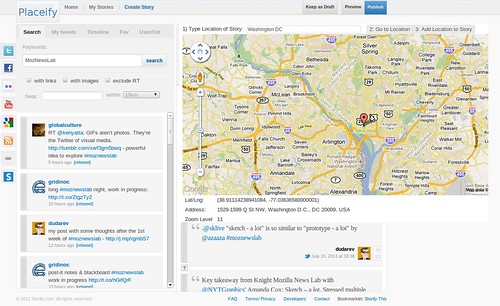He stressed that in order to devote yourself to making a successful large-scale project, you have to ask yourself if you are the right entrepreneur for the project. This has prompted some soul-searching on my part, and for the Public Radio Roadtrip my answer came back "yes." I'm irrationally and tenaciously passionate about this app and I see it as meeting a need both in the newsroom and in the community.
Herman then went on to stress that for any project to be successful, you "need to listen to what people are saying." He stressed that "you need to find the unsaid idea behind what people are saying" and that you need to "do [that] one thing head on."
And this got me thinking about audiences, I wonder if we also need to be more clear who our audiences are... I've been thinking a lot about this quote from the article "Investing in the future of news" A contributed chapter for 'Page One' edited by David Folkenflik
We found that projects made greater headway when they established an identity as part of a specific, tightly-defined community or interest group to attract passionate, repeat users. Journalists doing such outreach were more successful when they made themselves active members of the community, constantly asked for advice, showed that they were listening and made changes based on community input.I wonder if one potential audience for my app (outside reporters in the newsroom) would be a biking group, a car club or a geocaching interest group. I think they would clearly be the ones to give feedback on using maps and following routes. I think it would be great fun, it would be incredibly social to mash-up journalists and bicyclists in this kind of a way and see what happens.
Bert Herman mentioned having "as little possible barriers to adoption as possible." For Storify, one of these barriers was solved by simply allowing users to publish their work from Storify directly on their own web sites, within their own pages using a simple embed code. The Public Radio Roadtrip currently requires people to install a bookmarklet (intended to help make it easier for people to place stories from NPR.org on the map). I have a feeling that this bookmarklet might actually be a barrier to adoption.
Herman talked about the importance of design and for making things clean as the key for getting people to use your apps. With this in mind, I started working on a playful, two-minute mock-up of how the interface for the Public Radio Roadtrip could be cleaner and easier to use:

Oh, and I wasn't sure if it was Bert or Aza who gave us carte blanche to "steal!"
But really, the idea behind this graphic was to pose the idea of lowering barriers of adoption by brining a search inteface into the app (and eliminating the need for the bookmarklet). The other thing that this image meant to impress was the idea that the Public Radio Roadtrip intends to allow the user to curate points on the map from multiple sources, something that Herman's Storify does amazingly well.
Bert Herman advised us "when you find your passion, build your community." In addition to "dating" my co-founders as he cheekily but earnestly suggested, I can see myself alongside journalists and tourists, virtual tourists and bicyclists, graphic designers and marketers, bringing public radio stories out into the physical and digital streets and into the world.
2 comments:
Having worked on geolocation using sources such as twitter, I'm very intrigued about what you're planning. Since we're colleagues of the #MozNewsLab perhaps we can find some time to chat about your project in the coming week.
Absolutely, Juan. Your mentioning Twitter raises some interesting questions, so yes. Let's talk soon.
Post a Comment